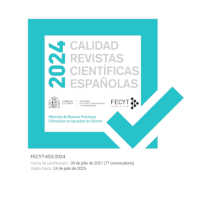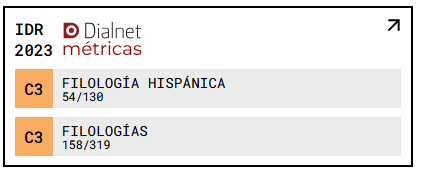The construction of "faits divers" in Félix Fénéon’s “microstories”
DOI:
https://doi.org/10.18172/cif.3501Keywords:
Fénéon, journalism, fait divers, minifiction, literature, black humorAbstract
The news, the newspaper headlines or the journalistic column are some of the precedents of the contemporary minifiction and with which this category has been related intertextually. These journalistic genres or discourses have served as patterns for creating not few narrative microforms. In some cases, these contributions originally appeared in the pages of newspapers, such as those written by Felix Fénéon between May and November 1906. This French anarchist and literary and art critic deals with a regular section in the newspaper Le Matin for seven months. In that section he was to summarize in less than 135 typographical characters current events supposedly taking place in French cities and towns. The formula he uses is based on what is known as fait divers. Written with a lot of irony and black humor, Fénéon's column is called “Nouvelles en trois lignes”. Based on the characterization of these press releases by various critics, such as Roland Barthes and others, this article examines the treatment of some of these faits divers, at the same time that it reflects on the fictional condition of these microtexts.
Downloads
References
ÁLAMO FELICES, F. (2009). “El microrrelato. Análisis, conformación y ficción de sus categorías narrativas”. Espéculo 42: 143 párrs. <http://www.ucm.es/info/especulo/numero42/microrre.html>. (Acceso 7 Septiembre 2017).
ÁLVARES, C. (2013). “Nouveaux genres littèraires urbains en français. Micronouvelles et nouvelles en trois lignes”. Diacrítica 27 (3): 159-182. <http://www.scielo.mec.pt/pdf/dia/v27n3/v27n3a11.pdf>. (Acceso 19 Septiembre 2017).
ANDRES-SÚAREZ, I. 1997 (1995). “El micro-relato. Intento de caracterización teórica y deslindes con otras formas literarias afines” en Teoría e interpretación del cuento. (Ed. P. Fröhlicher y G. Güntert). Bern: Peter Lang: 87-102.
ANDRES-SUÁREZ, I. (2010). El microrrelato español: Una estética de la elipsis. Palencia: Menoscuarto.
AUCLAIR, G. (1970). Le Mana quotidien: Structures et fonctions de la chronique des fait divers. Paris: Anthropos.
BARTHES, R. (2003). “Estructura del ‘suceso’” en Ensayos críticos. (Trad. C. Pujol). Barcelona: Seix Barral: 259-272.
BAUDRILLARD, J. (2009). La sociedad de consumo: Sus mitos, sus estructuras. (Est. introd. L. E. Alonso. Trad. A. Bixio). Madrid: Siglo XXI de España.
BENJAMIN, W. (2012). El París de Baudelaire. (Trad. M. Dimópulus). Buenos Aires: Eterna Cadencia.
BOURDIEU, P. (1997). Sobre la televisión. (Trad. Thomas Kauf). Barcelona: Anagrama.
CALVO REVILLA, A. (2012). “Delimitación genérica del microrrelato: microtextualidad y micronarratividad” en Las fronteras del microrrelato: Teoría y crítica del microrrelato español e hispanoamericano. (Ed. A. Calvo Revilla y J. de Navacués). Madrid/Frankfurt am Main: Iberoamericana/Vervuert: 15-36. DOI: https://doi.org/10.31819/9783954870103-002
CORTÁZAR, J. 1974 (1969). “Del cuento breve y sus alrededores” en Último Round. México, D.F.: Siglo XXI: 59-82.
CRAGIN, Th. (2006). Murder in Parisian Streets: Manufacturing Crime and Justice in the Popular Press, 1830-1900. Lewisburg: Bucknell University Press.
EICHENBAUM, B. 2007 (1970). “La teoría del ‘método formal’” en Teoría de la literatura de los formalistas rusos. (Ed. T. Todorov. Trad. A. M. Nethol). México, D.F.: Siglo XXI: 21-54.
FÉNÉON, F. (1948). Nouvelles en trois lignes. Paris. Gallimard.
FÉNÉON, F. (1970). Oeuvres plus que complètes (Éd. J. H. Halperin). Vol. II. Genève/Paris: Librairie Droz.
FÉNÉON, F. (1990). Nouvelles en trois lignes. Paris: Macula.
FÉNÉON, F. (1997-1998). Nouvelles en trois lignes. Paris: Mercure de France.
FÉNÉON, F. (1998). Nouvelles en trois lignes. Paris: Librairie Gènèrale Française.
FÉNÉON, F. (2007). Novels in Three Lines. (Trans. and introd. L. Sante). New York: The New York Review of Books.
FÉNÉON, F. (2009). Nouvelles en trois lignes. Grenoble: Cent Pages.
FÉNÉON, F. (2009). Romanzi in tre righe. (Trad. M. Codignola). Milano: Adelphi.
FÉNÉON, F. (2011). Novelas en tres líneas. (Introd. A. Jiménez Morato. Trad. Lluís Maria Todó). Madrid: Impedimenta.
FÉNÉON, F. (2017). Nouvelles en trois lignes. Saint Clément de rivière: Fata Morgana.
FÉNÉON, F. (2017). In drei Zeilen. (Ausg. und übers. J. Ritte). Zürich: Diaphanes.
FERRO, M. (2003). “La historia y las noticias sueltas” en Diez lecciones sobre la historia del siglo XX. (Trad. R. Vinós). México, D.F.: Siglo XXI: 121-130.
HERRERO CECILIA, J. (2016). “El género del suceso mediático (‘fait divers’) y las características de la narración del acontecimiento en los textos de la prensa francesa: la mitificación del personaje y la proyección e identificación del lector” en Texto, género y discurso en el ámbito francófono. (Ed. T. Gonzalo Santos, M. V. Rodríguez Navarro, A. T. González Hernández y J. M. Pérez Velasco). Salamanca: Universidad de Salamanca: 859-874. DOI: https://doi.org/10.2307/j.ctt1hrdn4p.75
HOWE, I. (1982). “Introduction” in Short Shorts: An Anthology of the Shortest Stories. (Ed. I. Howe and I. W. Howe). Boston/London: David R. Godine: ix-xvii.
LAGMANOVICH, D. (2006). El microrrelato: Teoría e Historia. Palencia: Menoscuarto.
MERLEAU-PONTY, M. (1954). “Le goût por les faits divers est-il malsain?”. L’Express 18.12.1954: 3-4. DOI: https://doi.org/10.1515/mamm.1954.18.4.420
MERLEAU-PONTY, M. (1960). “Sur les faits divers” en Signes. Paris: Gallimard: 388-391.
MERLEAU-PONTY, M. (1964). “A propósito de los sucesos” en Signos (Trad. C. Martínez y G. Oliver). Barcelona: Seix Barral: 381-384.
MONTERO, R. (2003). La loca de la casa. Madrid: Santillana Ediciones Generales.
MORA, C. de (2012). “El microrrelato intercalado y la metaficción en Respiración artificial y Nocturno de Chile” en Las fronteras del microrrelato: Teoría y crítica del microrrelato español e hispanoamericano. (Eds. A. Calvo Revilla y J. de Navascués). Madrid/Frankfurt: Iberoamericana/Vervuert: 193-206. DOI: https://doi.org/10.31819/9783954870103-013
NOGUEROL, F. (1992). “Sobre el micro-relato latinoamericano: Cuando la brevedad noquea...”. Lucanor 6: 117-133.
NOGUEROL, F. (1996). “Micro-relato y posmodernidad: textos nuevos para un final de milenio”. Revista Interamericana de Bibliografía 1-4: 12 párrs. <http://www.educoas.org/portal/bdigital/contenido/rib/rib_1996/articulo4/index.aspx?culture=es&navid=201>. (Acceso 10 Septiembre 2017).
PLANELLS, A. (1992). “Bosquejo dialéctico de la minificción”. Iberoromania 35: 33-49. DOI: https://doi.org/10.1515/iber.1992.1992.35.33
ROAS, D. (2011). “Breve reflexión sobre el (supuesto) estatuto genérico del microrrelato”. Plesiosaurio 1-4: 13-24 <http://issuu.com/plesiosaurio.peru/docs/plesiosaurio_04-1>. (Acceso 6 Septiembre 2017).
RÓDENAS DE MOYA, D. (2007). “Consideraciones sobre la estética de lo mínimo” en Mundos mínimos: El microrrelato en la literatura española contemporánea. (Ed. Teresa Gómez Trueba). Valladolid/Gijón: Cátedra Miguel Delibes/Llibros del Pexe: 67-93.
ROMI (1962). Histoire des fait divers. (Préf. M. Garçon). Paris: Pont Royal.
ROTGER, N. y VALLS, F. (2005). “El microrrelato o la apuesta por un género nuevo” en Ciempiés: Los microrrelatos de Quimera. (Ed. N. Rotger y F. Valls). Barcelona: Montesinos: 7-14.
SCHWARTZ, V. R. (1995). “Cinematic Spectatorship before the Apparatus: The Public Taste of Reality in Fin-de-Siècle Paris” in Viewing Positions: Ways of Seeing Film. (Ed. L. Williams). New Brunswick: Rutgers University Press: 87-113.
SEGUIN, J.-P. (1959). Nouvelles à sensations: Canards du XIXe siècle. Paris: Armand Colin.
STEVICK, Ph. (Ed.) (1971). Anti-Story: An Anthology of Experimental Fiction. (Ed. Ph. Stevick). New York: The Free Press.
THIRLWELL, A. (2014). La novela múltiple. (Trad. A. Montoto). Barcelona: Anagrama.
URDÍROZ VILLANUEVA, N. (1995). La ‘nouvelle’ en la historia literaria. Córdoba: Instituto de Historia de Andalucía/Universidad de Córdoba.
VALADÉS, E. (1993). “Ronda por el cuento brevísimo” en Del cuento y sus alrededores. (Ed. C. Pacheco y L. Barrera Linares). Caracas: Monte Ávila Latinoamericana: 281-268.
VALLES CALATRAVA, J. R. (2008). Teoría de la narrativa. Una perspectiva sistemática. Madrid/Frankfurt am Main: Iberoamericana/Vervuert. DOI: https://doi.org/10.31819/9783954871551
VALLS, F. (2015). “El microrrelato como género literario” en MicroBerlín: De microficciones y microrrelatos. (Eds. O. Ette, D. Ingernschay, F. Schmidt-Welle y F. Valls). Madrid/Frankfurt am Main: Iberoamericana/Vervuert: 21-49.
VANDENDORPE, Ch. (1991). “De la fable au fait divers”. Les cahiers de recherche du CIADEST 10: 1-19. <https://ruor.uottawa.ca/bitstream/10393/12789/3/Vandendorpe_Christian_1991_De_la_fable_au_fait_divers.pdf> (Acceso 21 Septiembre 2017).
ZAVALA, L. (2004). Cartografías del cuento y la minificción. Sevilla: Renacimiento.
ZAVALA, L. (2006). La minificción bajo el microscopio. México, D.F.: Universidad Nacional Autónoma de México.
Downloads
Published
How to Cite
Issue
Section
License
The authors retain copyright of articles and authorize CIF the first publication. They are free to share and redistribute the article without obtaining permission from the publisher as long as they give appropriate credit to the editor and the journal.
Self-archiving is allowed too. In fact, it is recommendable to deposit a PDF version of the paper in academic and/or institutional repositories.
It is recommended to include the DOI number.
This journal is licensed under a Creative Commons Attribution 4.0 International License














